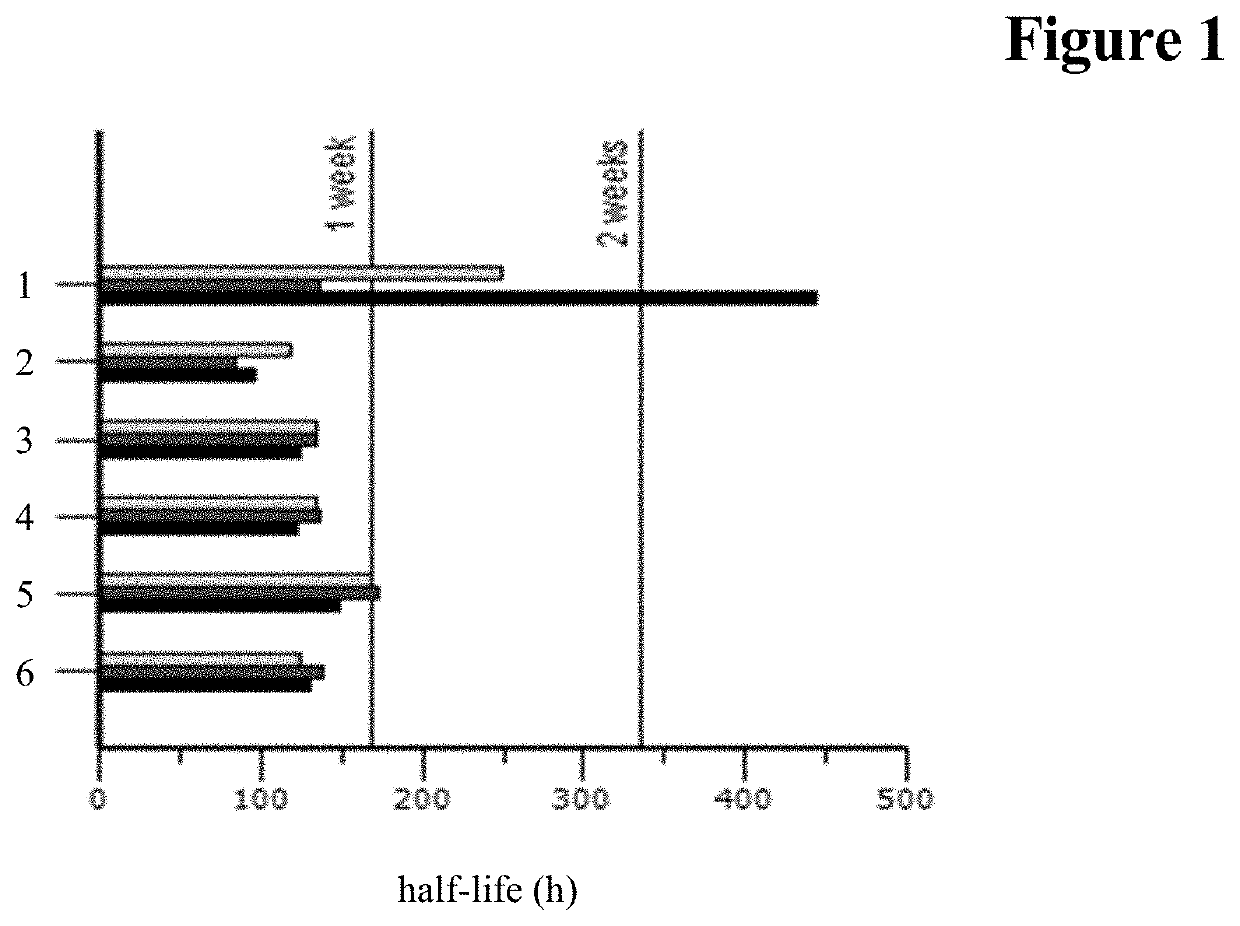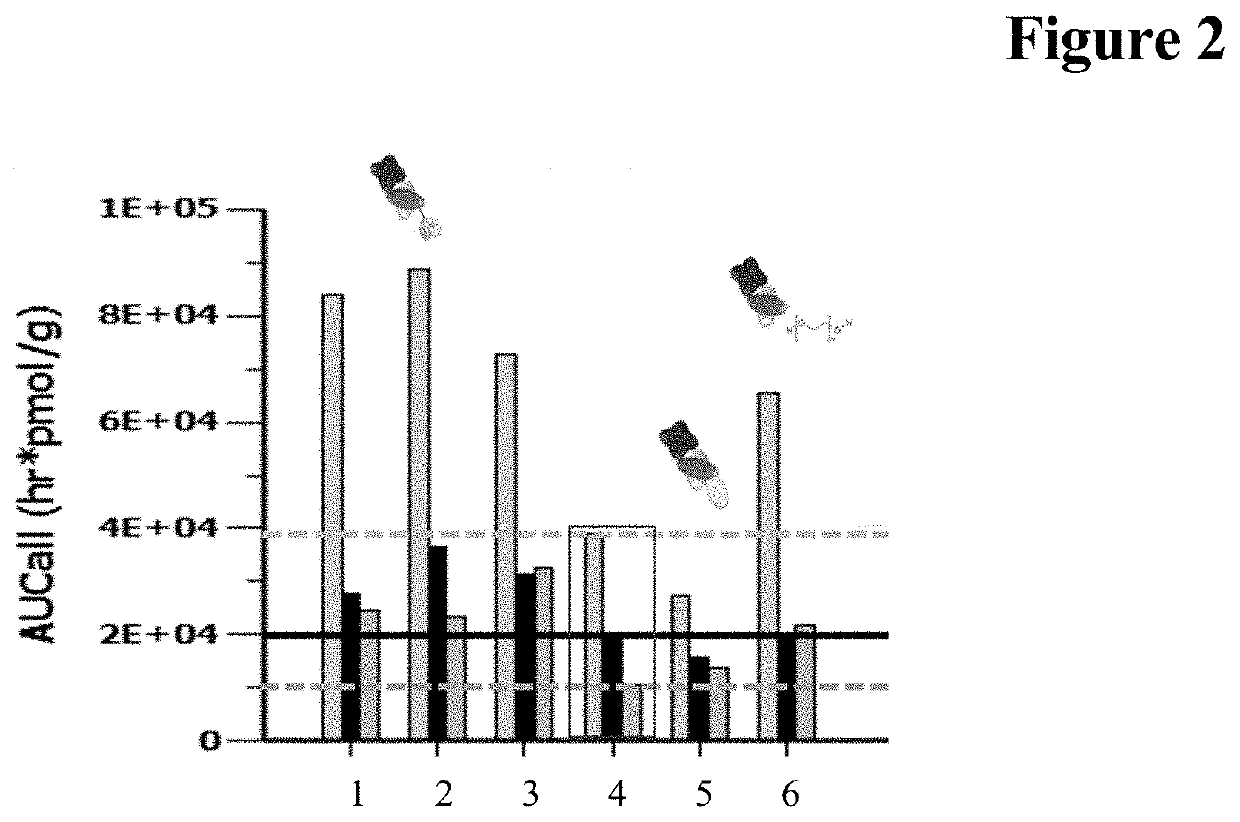Fusion proteins for opthalmology with increased eye retention
a technology of opthalmology and fusion proteins, which is applied in the field of ophthalmologic diseases and their treatment, can solve the problems of not being clinically viable, and achieve the effect of improving intravitreal retention and sufficient loading
- Summary
- Abstract
- Description
- Claims
- Application Information
AI Technical Summary
Benefits of technology
Problems solved by technology
Method used
Image
Examples
example 1
[0379]Expression and Purification
[0380]Transient Transfections in HEK293-F System
[0381]The fusion constructs were generated by transient transfection with the respective plasmids using the HEK293-F system (Invitrogen) according to the manufacturer's instruction. Briefly, HEK293-F cells (Invitrogen) growing in suspension either in a shake flask or in a stirred fermenter in serum-free FreeStyle™ 293 expression medium (Invitrogen) were transfected with a mix of the respective expression plasmids and 293Fectin™ or fectin (Invitrogen). For 2 L shake flask (Corning) HEK293-F cells were seeded at a density of 1*106 cells / mL in 600 mL and incubated at 120 rpm, 8% CO2. The day after the cells were transfected at a cell density of approx. 1.5*106 cells / mL with approx. 42 mL of a mixture of A) 20 mL Opti-MEM (Invitrogen) with 600 μs total plasmid DNA (1 μg / mL) encoding the heavy or modified heavy chain, respectively and the corresponding light chain in an equimolar ratio and B) 20 ml Opti-MEM ...
example 2
[0388]Binding to Human and Porcine Collagen II
[0389]Binding kinetics of anti-collagen antibodies to human Collage type II (Millipore CC052) and porcine Collagen type II (USBiological C7510-31) was investigated by surface plasmon resonance using a BIAcore T200 instrument (GE Healthcare). All experiments were performed at 25° C. using HBS-P (10 mM His, 140 mM NaCl, 0.05% Tween 20 pH 7.4) as running and dilution buffer. Collagen type II was immobilized on a Series S CMS Sensor Chip (GE Healthcare) using standard amine coupling chemistry. Anti-Collagen antibodies were injected for 180 s with concentrations from 1.23 up to 900 nM (1:3 dilution series) onto the surface (association phase). The dissociation phase was monitored for 600 sec by washing with running buffer. The surface was regenerated by injecting 0.85% H3PO4 for 60 sec. Bulk refractive index differences were corrected by subtracting the response obtained from a mock surface. Blank injections were subtracted (double referencin...
example 3
[0390]Minipig Pharmacokinetic Study
[0391]Female minipigs, 7-8 kg each, were administered 1.25 nmol of each drug by IVT injection. The aimed initial concentration was 500 nM in the eye for each molecule. Vitreous, retina and choroid samples were collected at three termination time points 168, 336 and 672 hours after application.
PUM
| Property | Measurement | Unit |
|---|---|---|
| molecular weight | aaaaa | aaaaa |
| concentration | aaaaa | aaaaa |
| concentration | aaaaa | aaaaa |
Abstract
Description
Claims
Application Information
 Login to View More
Login to View More - R&D
- Intellectual Property
- Life Sciences
- Materials
- Tech Scout
- Unparalleled Data Quality
- Higher Quality Content
- 60% Fewer Hallucinations
Browse by: Latest US Patents, China's latest patents, Technical Efficacy Thesaurus, Application Domain, Technology Topic, Popular Technical Reports.
© 2025 PatSnap. All rights reserved.Legal|Privacy policy|Modern Slavery Act Transparency Statement|Sitemap|About US| Contact US: help@patsnap.com


